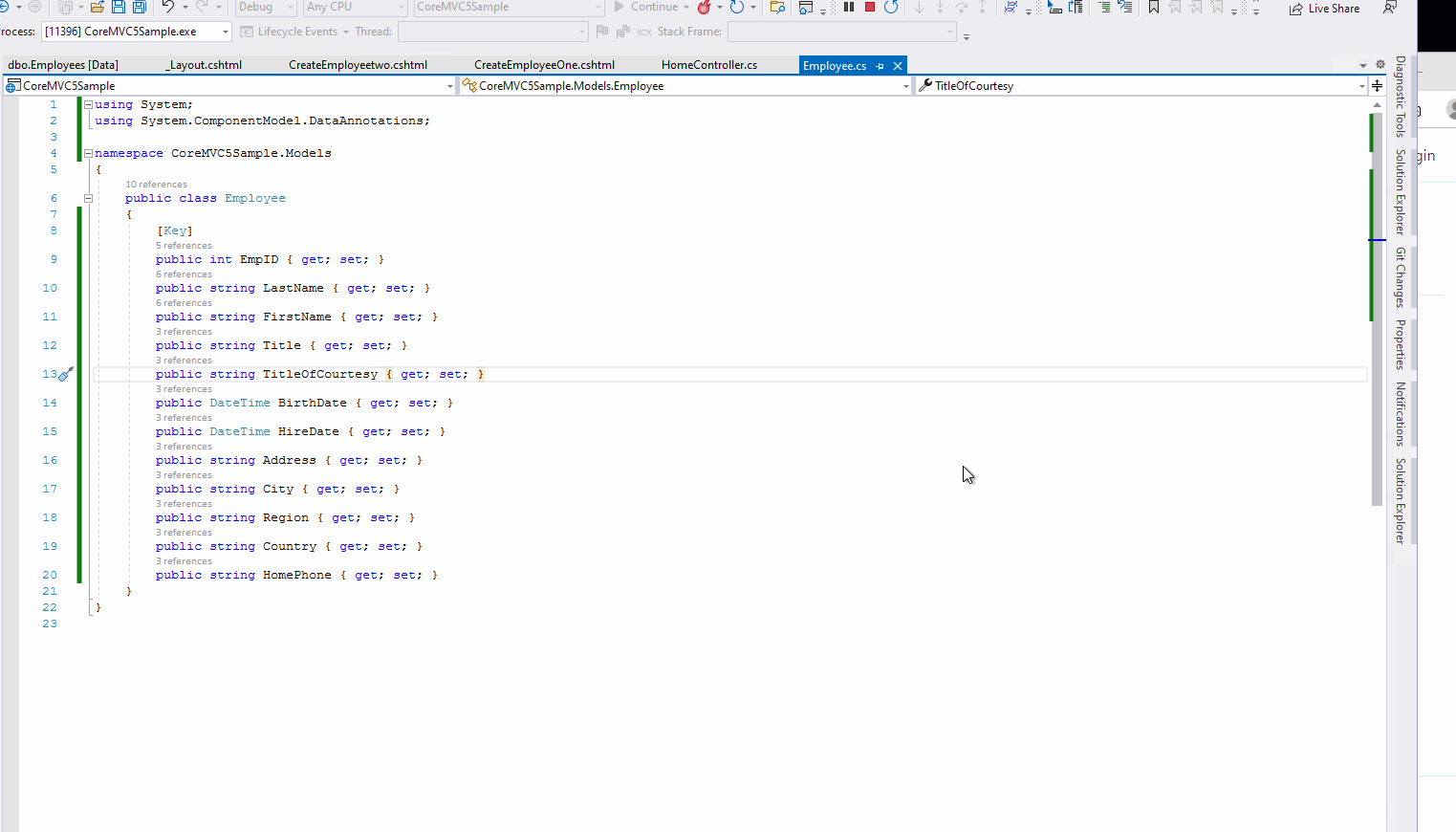Hi @Roger Porter ,
I do a submit on view one which then saves the data to the database. When I load that same row up and pass it to view two it has my data from view one. The problem is in view two I don't use all the properties that view one used. When I do a submit on view two all the properties that are not used and that was populated in view one are blank or null. I am guessing because those properties are not bound to any controls so on the client side there is no way of storing them.
You are right. When we submit the form to action method, it will based on the form elements to bind the model/parameter, if you haven't bound the property (the property used in view one) in the View two, after click the submit button, in the View two's post method, these properties will be null.
To prevent this behavior, on the view to get action method, you can get the view one data from the database, then, return the data to View two, in the view page, use a hidden field to store these properties, after that, when you click the submit button, you can get these hidden properties in the View two post method.
Refer to the following sample code:
Here I have a Employee class:
public class Employee
{
[Key]
public int EmpID { get; set; }
public string LastName { get; set; }
public string FirstName { get; set; }
public string Title { get; set; }
public string TitleOfCourtesy { get; set; }
public DateTime BirthDate { get; set; }
public DateTime HireDate { get; set; }
public string Address { get; set; }
public string City { get; set; }
public string Region { get; set; }
public string Country { get; set; }
public string HomePhone { get; set; }
}
In the controller, create action for the two views:
public class HomeController : Controller
{
private readonly ApplicationDbContext _context;
public HomeController(ApplicationDbContext applicationDbContext )
{
_context = applicationDbContext;
}
public IActionResult CreateEmployeeOne()
{
return View();
}
[HttpPost]
public IActionResult CreateEmployeeOne( Employee employee)
{
if (!ModelState.IsValid)
{
return View(employee);
}
_context.Employees.Add(employee);
_context.SaveChanges();
//redirect to view two and transfer the new employee id to the view two.
return RedirectToAction(nameof(CreateEmployeetwo), new { empid = employee.EmpID });
}
[HttpGet]
public IActionResult CreateEmployeetwo(int empid)
{
var employee = new Employee();
if (empid != 0)
{
//based on the id to find the employees from database.
employee = _context.Employees.First(c => c.EmpID == empid);
}
return View(employee);
}
[HttpPost]
public IActionResult CreateEmployeetwo(Employee employee)
{
return View();
}
Then, in the view one (CreateEmployeeOne.cshtml) form tag, only display the first name and last name:
@model CoreMVC5Sample.Models.Employee
<div class="row">
<div class="col-md-4">
<form asp-action="CreateEmployeeOne">
<div asp-validation-summary="ModelOnly" class="text-danger"></div>
<div class="form-group">
<label asp-for="LastName" class="control-label"></label>
<input asp-for="LastName" class="form-control" />
<span asp-validation-for="LastName" class="text-danger"></span>
</div>
<div class="form-group">
<label asp-for="FirstName" class="control-label"></label>
<input asp-for="FirstName" class="form-control" />
<span asp-validation-for="FirstName" class="text-danger"></span>
</div>
<div class="form-group">
<input type="submit" value="Create" class="btn btn-primary" />
</div>
</form>
</div>
</div>
In the View two (CreateEmployeetwo.cshtml): we can use the hidden filed control or add hidden attribute on the html elments.
@model CoreMVC5Sample.Models.Employee
<div class="row">
<div class="col-md-4">
<form asp-action="CreateEmployeetwo">
<div asp-validation-summary="ModelOnly" class="text-danger"></div>
<div class="form-group">
<label asp-for="EmpID" class="control-label"></label>
<input asp-for="EmpID" class="form-control" />
<span asp-validation-for="EmpID" class="text-danger"></span>
</div>
<div class="form-group">
<label asp-for="LastName" class="control-label"></label>
<input asp-for="LastName" class="form-control" />
<span asp-validation-for="LastName" class="text-danger"></span>
</div>
<div class="form-group" hidden>
<label asp-for="FirstName" class="control-label"></label>
<input asp-for="FirstName" class="form-control" />
<span asp-validation-for="FirstName" class="text-danger"></span>
</div>
<div class="form-group">
<label asp-for="Title" class="control-label"></label>
<input asp-for="Title" class="form-control" />
<span asp-validation-for="Title" class="text-danger"></span>
</div>
<div class="form-group">
<label asp-for="TitleOfCourtesy" class="control-label"></label>
<input asp-for="TitleOfCourtesy" class="form-control" />
<span asp-validation-for="TitleOfCourtesy" class="text-danger"></span>
</div>
<div class="form-group">
<label asp-for="BirthDate" class="control-label"></label>
<input asp-for="BirthDate" class="form-control" />
<span asp-validation-for="BirthDate" class="text-danger"></span>
</div>
<div class="form-group">
<label asp-for="HireDate" class="control-label"></label>
<input asp-for="HireDate" class="form-control" />
<span asp-validation-for="HireDate" class="text-danger"></span>
</div>
<div class="form-group">
<label asp-for="Address" class="control-label"></label>
<input asp-for="Address" class="form-control" />
<span asp-validation-for="Address" class="text-danger"></span>
</div>
<div class="form-group">
<label asp-for="City" class="control-label"></label>
<input asp-for="City" class="form-control" />
<span asp-validation-for="City" class="text-danger"></span>
</div>
<div class="form-group">
<label asp-for="Region" class="control-label"></label>
<input asp-for="Region" class="form-control" />
<span asp-validation-for="Region" class="text-danger"></span>
</div>
<div class="form-group">
<label asp-for="Country" class="control-label"></label>
<input asp-for="Country" class="form-control" />
<span asp-validation-for="Country" class="text-danger"></span>
</div>
<div class="form-group">
<label asp-for="HomePhone" class="control-label"></label>
<input asp-for="HomePhone" class="form-control" />
<span asp-validation-for="HomePhone" class="text-danger"></span>
</div>
<div class="form-group">
<input type="submit" value="Create" class="btn btn-primary" />
</div>
</form>
</div>
</div>
The result is like this: as we can see that, after click the submit button in the view one, in its post method, we can see only the first name and last name has value:

Note: In the above sample, we should follow the order to create an employee: click the view one first (to enter the first name and last name) and then click the submit button in view one, it will redirect to view two, then we can enter other properties.
If the answer is the right solution, please click "Accept Answer" and kindly upvote it. If you have extra questions about this answer, please click "Comment".
Note: Please follow the steps in our documentation to enable e-mail notifications if you want to receive the related email notification for this thread.
Best regards,
Dillion
